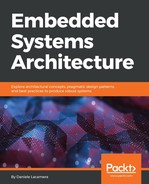Depending on the use cases, each embedded system may benefit from the communication facilities offered by the technologies described in this section. Due to the high specialization of some embedded devices, a design tailored to specific use cases may even go beyond this classification and use technologies that are designed for one specific use case. Wireless communication is impossible in some cases, due to emission regulations in some environments, and when the media is not capable of transporting radio waves reliably, such as underwater or through the human body.
Submarines may communicate by specific transceivers, using sound waves to represent the data. Special technologies have been researched to improve communication for wearable devices, such as NXP MiGLO, which uses the near-field magnetic induction (NFMI) mechanism, increasing the range and efficiency of body networks when compared to wireless radio. Other widespread technologies are available for wired communication as well. Power line communication allows the reusing of existing wires to refit older devices and bring local network connectivity, extending Ethernet or serial interfaces bus using high frequency modulation that does not impact on the original purpose of the wires used.
As it turns out, embedded devices are offered a broad range of possibilities when it comes to connectivity. The optimal choice always depends on the specific use case and the resources available on the system to implement protocols and standards required to reach the other endpoints of the communication. When selecting a communication technology, there might be several aspects to take into account:
- Range of communication
- Bit rate required for data transfer
- Total cost of ownership (transceiver price, integration effort, service costs)
- Media-specific limitations, such as latency introduced by the transceiver
- Impact of the RF interference on the hardware design requirements
- Maximum transfer unit
- Power consumption, energy footprint
- Protocols/standards supported for compatibility with third-party systems
- Compliance to internet protocols for integration in IoT systems
- Topology flexibility, dynamic routing, mesh network feasibility
- Security model
- Resources required to implement drivers and protocols for a specific technology
- Use of open standards to avoid lock-in for long-lived projects
Each and every technology for connected devices offers a different take on how these aspects are addressed in its intrinsic design, also depending on whether the technology has been borrowed from a different context, such as Ethernet or GSM/LTE, or has been designed with low-power embedded systems in mind, as in RL-WPAN and LWPAN protocols.
Selecting the appropriate communication channels when designing distributed systems is an operation that requires strict collaboration between hardware and software design, to truly understand the challenges posed by the additional complexity of creating connected devices, especially in the low-power domain.
The next section focuses on how the implementation of IPs can be adapted to scale down to embedded devices, in all those cases where the IP-to-the-host approach has been selected, and the TCP/IP stack can be extended and configured to meet the requirements of an IoT-distributed system. Cases where non-IP protocols are translated by a border gateway to integrate non-standard communication in IoT systems are not covered, as both the TCP/IP endpoints lie outside the scope of the embedded development in the distributed system.
